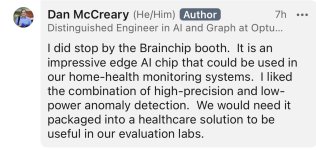When I stepped away a few months ago I stated that I held the view that Brainchip’s success was no longer in doubt.
This view has in my opinion been further validated by one recently disclosed FACT in the half yearly report which stated that an additional $2 million approximately was received predominately made up of additional licence fees from MegaChips.
We know as a matter of FACT from the two ASX announcements regarding MegaChips that it was committed to pay about $2 million for its own AKIDA IP licence.
We know that Renesas paid somewhere in the order of half to one million dollars for its licence of two nodes of AKIDA IP.
So we can extrapolate that the about $2 million dollars in licence fees received from MegaChips OVER AND ABOVE its $2 million involves one or more AKIDA IP licence fees being paid by one or more customers of MegaChips.
Those of us who have been on this journey for years know that what we have wanted and what others have constantly criticised Brainchip for not achieving is conversion of sales leads into paying customers.
Even today we have posters legitimately hoping for an ASX price sensitive announcement that Valeo, Ford, Mercedes Benz or the like have moved from EAP to customer by purchasing an AKIDA IP licence.
Why because the way in which the Brainchip sales pipeline works is that purchase of the AKIDA IP licence comes at the end when a company has reached the point where it has a proof of concept prototype and is going to bring a product containing AKIDA IP to market and in due course start remitting royalties to Brainchip in perpetuity.
The now known FACT is that via MegaChips one or more early access customers have reached that point and paid an AKIDA IP licence fee and are bringing a product to market containing AKIDA IP.
This is what the journey has been all about.
Obviously we do not know who these now committed customers are but we do have the following from MegaChips as to where they were targeting the use of AKIDA IP.
We also have from the CEO Sean Hehir that to understand the progress being made we need to look to revenue.
Well I have and in doing so I have been informed that MegaChips has been successful in selling AKIDA IP to one or more customers who will be bringing a product to market powered by AKIDA and in due course royalties will flow to Brainchip in perpetuity.
My opinion only DYOR
FF
AKIDA BALLISTA

MAIN MENU

Artificial Intelligence / Machine Learning
Megachips is dedicated to bringing a broad range of solutions to customers building products requiring “Edge AI” capability. Megachips has partnered with two leading Edge AI/IP vendors to enable us to deliver the optimal solutions with comprehensive design and manufacturing support.
AI Enablement Program
MegaChips has introduced a unique program to support both systems companies embedding AI into their products and IP companies who need to demonstrate their unique capabilities to their customers.
Features and Benefits of the Program – for systems companies
- Dedicated team of engineers and FAE’s to work with our customers to identify the best way to implement their desired AI functionality
- A variety of software and hardware demonstrations which feature the implementation of different AI algorithms on different platforms
- The ability to develop custom “proof of concept” demonstrations to illustrate and validate a customers desired functionality
- Help customer optimize AI solution in context of complete system – including foundry process node
Features and Benefits of the Program – for IP vendors
- Opportunity to partner with MegaChips in joint sales and marketing programs
- Allow the IP vendor to focus on their key strengths.
- Eliminate the need for the IP vendor to find and hire a back-end chip implementation team and develop relationships with foundries, assembly vendors, etc.
- Provide strong partnership based on our AI system and implementation skills
- Help IP vendor choose the best process node based on the target market and cost of implementation of final customer’s SoC
- Ensure top quality for the final product
Brainchip features a unique neuromorphic processor which takes advantage of the sparse data streams associated with most edge applications to provide a very low power solution while maintaining high performance. The small footprint of the Brainchip IP makes it an ideal solution for low power, high volume applications.
Megachips’ engineering team is fully trained on Brainchip software and hardware and is prepared to work directly with our customers to evaluate the performance of the Brainchip Solution in your product.
Once selected MegaChips will work closely with our customers throughout the product development cycle, including licensing the SDK hardware and software, provide NN model consulting, and ensure the final design can be efficiently implemented into silicon.
Key Features
- Very low power – microwatts to milliwatts
- On chip learning – no need to retrain in the cloud
- Complete development system support
- Silicon-proven IP
- Software Development Kit available
Key Applications
- Keyword spotting
- Always on detection
- Gesture recognition
- Network packet inspection
- Person/object classification
- Object detection








